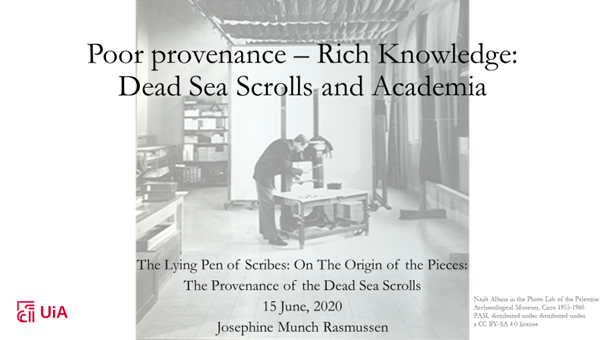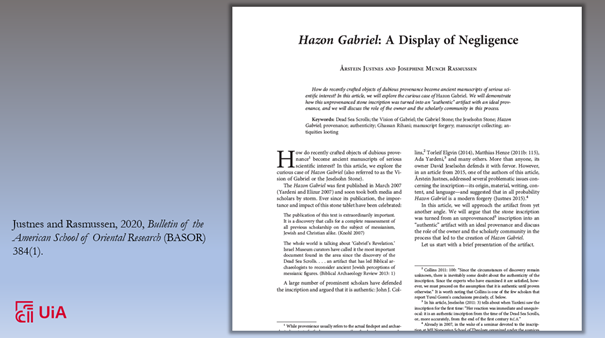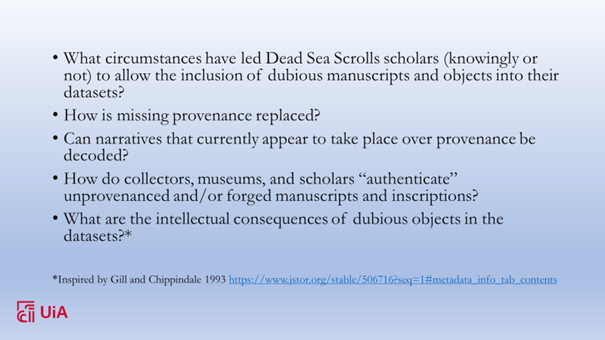I’m not a manuscript scholar. I’m trained as an archaeologist, but my research has revolved around antiquities trade, particularly on the receiving end (dealers, collectors, academics). Thanks for the invite to this cross-disciplinary seminar @arsteinjustnes
I’m interested in how institutions and academic communities source ancient material to produce knowledge about the past. At #OriginofthePieces I took the opportunity to discuss what kind of knowledge the Dead Sea Scrolls represent.
To me, the Dead Sea Scrolls are modern history, not so much an ancient one.
The DSS are rich sources of knowledge, less about ancient times, more about the institutions and academic traditions that invented them.
The DSS are rich sources of knowledge, less about ancient times, more about the institutions and academic traditions that invented them.
In the wake of exposure of forgery in undocumented DSS fragments, the concern seemed to revolve around
•Fright of data contamination
•Finding the forgers
•An intense interest in authenticity over provenance
•Fright of data contamination
•Finding the forgers
•An intense interest in authenticity over provenance
There seems to have been a tendency to search for bad apples among honest scholars and genuine fragments instead of looking for clues in the discipline.
But cases of forgery, theft, and lacking due diligence keep piling up
https://www.theoxfordblue.co.uk/2020/04/16/exclusive-christ-church-professor-arrested-over-scandal-of-stolen-papyrus/ and not least @museumofbible…
https://www.theoxfordblue.co.uk/2020/04/16/exclusive-christ-church-professor-arrested-over-scandal-of-stolen-papyrus/ and not least @museumofbible…
Despite wider implications, e.g. https://rb.gy/pcgm8v @artcrimeprof, the framing persists h/t @michaelpress https://twitter.com/MichaelDPress/status/1246897456610189312?s=20 But really the cases are quite unsurprising outcomes of disciplinary practice in our research traditions
Basic premise: Our ability to theorize about the past depends on and is certainly constrained by the evidence that has survived. Scholars of ancient history typically engage with textual sources that have at some point been removed from an ancient site.
Wider context: Looting of objects through European colonization of the Middle East and North Africa conditioned the formation of ANE studies. Ex of how it feeds into current representations: https://therevealer.org/destruction-on-display-the-politics-of-preservation/ @RahaRafii
Academic research on newly discovered ancient manuscripts is largely based on objects arising from the antiquities markets. At the same time, market demand for archaeological texts creates incentives for forgery and theft.
As a major provider of unprovenanced ancient objects, the market is also a driving force behind massive looting and pillaging of archaeological sites worldwide, depriving communities & destroying invaluable sources of knowledge in the process.
So, paradoxically, while knowledge production is the basic justification for any scholarly study of ancient texts, one might suggest that the academic consumption of unprov artifacts undermines preservation, opens datasets to forgeries, and ultimately corrupts research
A material can be interpreted endlessly, but it can only be excavated once, so the quality and potential for knowledge coming out of it depends on the process and the documentation of it.
As shown repeatedly by the contributors to the #OriginofthePieces seminar: While there has been many excavations in Qumran, documentation of the extraction of scrolls is lacking
But text-based branches of studies in ancient artefacts do not necessarily ever meet archaeological objects in situ and don’t have to. Ancient manuscripts and other epigraphic material can be read regardless of whether they have an archaeological context: https://rb.gy/st3epd
A sidenote: more and more publishers have restrictions on publication of unprovenanced material, e.g. @archaeoloy_aia; @ASOResearch, even…
Biblical Archaeology Review has stated that it will “no longer be publishing unprovenanced objects that have come to light since 1970”. https://www.baslibrary.org/biblical-archaeology-review/46/1/9 (halleluja!)
As contended by Brodie and Kersel (2012): in biblical archaeology, there is a tendency that even when authenticity is the issue, and provenience is the ultimate guarantor of authenticity, provenience has seldom been the primary object of investigation https://rb.gy/ob9mvc
BUT this seems to be changing. The #Originofthepieces seminar is an example, and so is the critical work conducted across different manuscript studies and from insider’s perspective, such as Brent Nongbri, @RoslandToft, @ArsteinJustnes, @MichaelDPress, @papyrologyatman
Others still talk about “reconstructing provenance” which sounds so wonderfully optimistic.
Fex, Avana et al 2020 have applied advanced genetic testing to DSS fragments of animal skin to trace their origin and species https://www.cell.com/cell/fulltext/S0092-8674(20)30552-3
Fex, Avana et al 2020 have applied advanced genetic testing to DSS fragments of animal skin to trace their origin and species https://www.cell.com/cell/fulltext/S0092-8674(20)30552-3
It is assumed that since appears not to have been produced locally, some of the material must have been brought from elsewhere to Qumran. But this of course rests on several assumptions about the context of the finds.
We need to talk more about how provenance is understood in DSS: is it an entry in an auction catalogue? A DNA profile? A previous owner named Kando? A precise findspot, or the biography of the object post excavation?
On provenance and provenience https://scholarship.law.unc.edu/cgi/viewcontent.cgi?article=2080&context=ncilj @PGertstenblith h/t @mokersel
For two of the fragments in Anava’s study (4Q344 and 4Q59 frg. 25), it is stated that these most likely have been “unearthed in other caves in the Judean Desert” (Anava 2020,1228), or even that it was “brought from outside the Judean desert” quote https://rb.gy/h6ehm7
So: even when the study suggest that material did NOT come from the Qumran caves, the fragments are still put into that well known interpretive frame, the narrative of the Dead Sea Scrolls.
In a forthcoming article in BASOR @ASOResearch, Årstein and I address this tendency.
We use Hazon Gabriel as an example, the so called “Dead Sea Scroll in Stone” (yeah, it’s not a scroll, it’s a stone) that cannot be linked to a known finding place
We use Hazon Gabriel as an example, the so called “Dead Sea Scroll in Stone” (yeah, it’s not a scroll, it’s a stone) that cannot be linked to a known finding place
In 2015, @arsteinjustnes argued in an article that Hazon Gabriel is a modern forgery. In our forthcoming article @BASOResearch, we argue that HG was turned into an “authentic” artifact by way of the academic community
A rather haphazard patchwork of biblical phrases and elements from later literature, “biblical” expressions, numbers, and prominent figures, Hazon Gabriel is commonly described as “prophetic” by those who believe in it. “Nonsensical” seems more accurate.
Of the 87 lines, many of them fragmentary, barely a single one contributes substantial content. We believe that the text was written by a person who was “cutting and pasting” phrases and expressions from a variety of sources.
What should be noted, is the willingness of the academic community to overlook the red flags surrounding undocumented artifacts like Hazon Gabriel, most of all its lack of documentation and sudden appearance. This is also relevant for the post-2002 DSS like frg.
Tempting, I’m sure, but... dubious provenance cannot be circumvented by “optical due diligence” or lab tests for authenticity https://twitter.com/MichaelDPress/status/1239570478844518402?s=20
As stated by Mizzi and Magness (2019:146), [beyond forgeries] “the question of provenance is actually more fundamental and therefore of greater importance (…) https://brill.com/view/journals/dsd/26/2/article-p135_1.xml?language=en
“Not only do most of them [post-2002 DSS like frg] lack a known archaeological context, but their history of acquisition and ownership remains sketchy, to say the least” Mizzi and Magness (2019:146) https://brill.com/view/journals/dsd/26/2/article-p135_1.xml?language=en
In a forthcoming article to be published in DSD 28 no. 1 (2021), @arsteinjustnes and I argue that the problem is far from confined to the post-2002 fragments.
In a 2017 paper presented at the annual @SBLsite, @arteinsjustnes showed that some of the “DSS” ms published in DJD, especially those that surfaced in the nineties, have many of the same problems and traits as forged fragments that flooded the market post 2002:…
they are undocumented, unprovenanced, and have a dubious, and sometimes fabricated, ownership history.
Archaeologists will argue that a missing provenance limits the interpretations of artefacts. But quite often it seems to be the opposite: It’s a conveniently empty basket that can be filled with the dreams and wishes of scholars, dealers and collectors.
I’ve given some thought to a remark on nihilism that I got at #OriginofthePieces. I stand by my point that if data is treated appropriately and with accountability, the Dead Sea Scrolls have a somewhat limited value as sources of knowledge about ancient history.
As for nihilism: No need to clutch your pearls, Larry Schiffman. I’m not saying Dead Sea Scrolls are worthless. They are certainly rich sources of knowledge, but less about ancient times, more about the institutions and academic traditions that invented them #OriginofthePieces
Fex exhibitions: Here, Smithsonian 1965, exhibit of Dead Sea Scrolls from Jordan in the Foyer Gallery of the Natural History Building. The exhibition, 27 Feb. – 21 March, drew ca 210k visitors. Shoutout to @Ludvik_A_K making a searchable database on DSS exhibitions

 Read on Twitter
Read on Twitter






